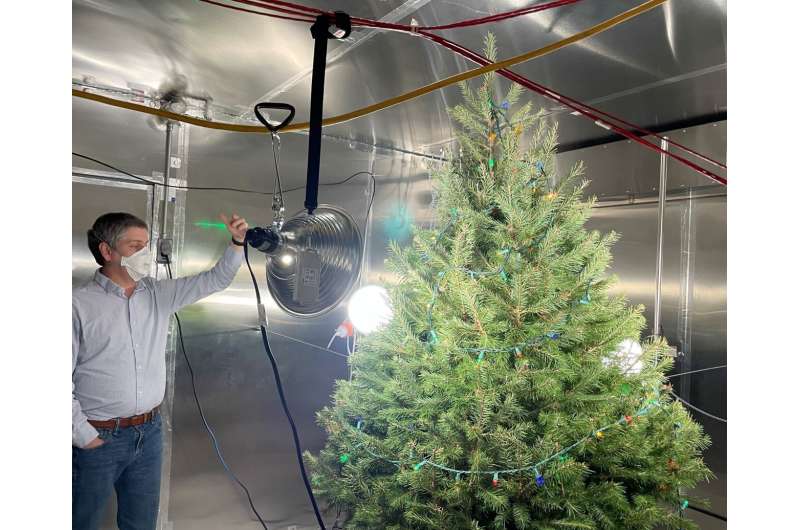This article has been reviewed according to Science X's editorial process and policies. Editors have highlighted the following attributes while ensuring the content's credibility:
fact-checked
trusted source
proofread
Live Christmas trees affect indoor air chemistry, researchers find

Every holiday season, Americans buy nearly 30 million live Christmas trees. Many families enjoy not only having a live tree inside their homes but also smelling the fresh fragrance it creates. That smell comes from chemicals called volatile organic compounds (VOCs). However, little is known about how much is emitted and whether they have any health impacts.
"Our nose is a good chemical sensor," said Dustin Poppendieck, an environmental engineer at the National Institute of Standards and Technology (NIST). "We know that these trees are emitting something, and the question then becomes: How big of a source is it? We wanted to explore which chemicals are emitted and how much, and to put that into the context of other sources of chemicals in a house," he said.
To answer these questions, Poppendieck and his NIST colleagues took a common type of Christmas tree—a Douglas fir— and sealed it inside a chamber. They then measured the amount and type of VOCs it emitted over 17 days. They also investigated whether the VOCs reacted with other components of indoor air to create new compounds.
The team's findings have been published in the journal Indoor Environments.
The fresh smell that is commonly associated with Christmas trees comes from a group of VOCs called monoterpenes, which are also found in air fresheners, candles, and some personal care products. In the outdoors, conifers, the group of plants that includes most Christmas trees, release monoterpenes, and they can affect outdoor air quality. But little is known about how much monoterpene is released when a tree is cut down and placed indoors.
Studies also show monoterpenes can react with ozone. Ozone in the upper atmosphere serves as a protective barrier against the sun. At ground level, ozone is created through chemical reactions with light and can cause symptoms such as coughing and throat irritation. Ozone also reacts readily with other chemicals in the air to form new compounds. So, the researchers were interested in seeing the effects of ozone in the presence of an indoor tree.
They placed it inside an environmentally controlled chamber, where they could measure the chemicals emitted from the tree in real-time. Using a technique that can detect airborne organic compounds, known as proton-transfer reaction mass spectrometry (PTR-MS), they measured the VOCs emitted over a 17-day period.
In their experiment, the researchers simulated a home environment. They decorated the tree in a typical holiday lighting setup and shone bright lights on it to mimic the day-night cycle. They turned off the lights every 12 hours and watered the tree every day. They brought in outside air at a rate typical for households, and constantly measured chemicals in the indoor air.
Monoterpenes were the most abundant VOC emitted from the tree. They peaked during the first day before diminishing significantly by the third day. Their concentration was initially at the same level of a plug-in air freshener or newly constructed house before it quickly dropped by nearly 10 times its original amount, said Poppendieck. The researchers detected 52 distinct types of monoterpenes.
Researchers then injected ozone into the chamber to see how it affected indoor air chemistry. They found that ozone reacted with the monoterpenes, forming byproducts such as formaldehyde, another type of VOC, as well as other reactive chemicals. The monoterpene concentration diminished even more with the introduction of ozone, while formaldehyde levels rose, which showed an impact on indoor air chemistry. However, the amount of formaldehyde created was relatively small at around one part per billion. Typical U.S. houses have formaldehyde concentrations ranging from 20 to 30 parts per billion.
For people who are sensitive to VOCs, Christmas trees could be one possible cause for watery eyes and noses, especially when initially brought indoors. In that case, Poppendieck suggests, opening a window near the tree will reduce exposure. In addition, newly cut trees can be left outdoors or in a garage for three days before bringing them into the home as the emission strength naturally decays over time.
"But for most people," Poppendieck said, "this shouldn't be a major concern. I'm still going to have a Christmas tree in my house."
More information: Dustin Poppendieck et al, Jingle bells, what are those smells? Indoor VOC emissions from a live Christmas tree, Indoor Environments (2023). DOI: 10.1016/j.indenv.2023.100002
Provided by National Institute of Standards and Technology





















